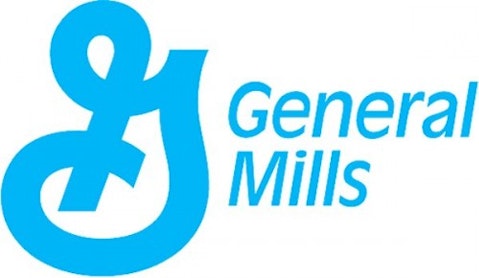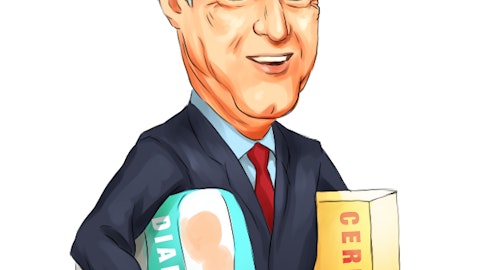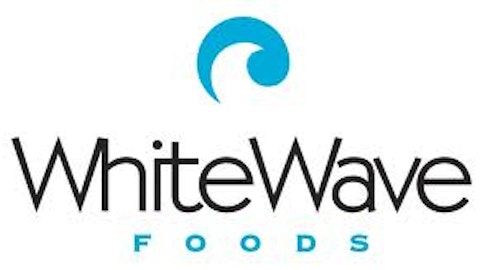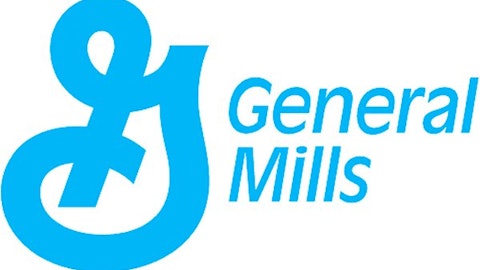General Mills, Inc. (NYSE:GIS) posted stronger-than-expected earnings for its fourth quarter of fiscal year 2015 which ended May 31, but the firm’s revenues were lower than what Wall Street was expecting. Quarterly net income was reported to be $186.8 million, or $0.30 per share, down significantly from $404.6 million, or $0.65 per share, in the same quarter of the prior year. Adjusted earnings, however, were reported to be $0.75 per share, while analysts were predicting $0.73 per share. Revenues, on the other hand, rose to $4.30 billion from $4.28 billion in the year-ago quarter, though they still missed analysts’ estimates of $4.53 billion. However, when accounting for foreign exchange fluctuations, revenues increased by 6% and would have slightly topped estimates. For the entire 2015 fiscal year, General Mills reported that net sales declined by 2% to $17.6 billion, while adjusted EPS increased by 1% to $2.86.

The smart money was not likely expecting any major surprises in this latest earnings report, as sentiment among hedge funds was relatively tame. The number of bullish hedge fund bets stayed the same, which is a slightly negative development in our experience, as the firm was in 24 hedge funds’ portfolios at the end of the first quarter of 2015, same as the prior quarter. When it comes to total value of holdings, however, there was a significant increase to $423.29 million, up 34.22% from the previous quarter. The stock climbed just 6.13% in the first quarter, which means the hedge funds who were long on the stock amassed quite a few more shares in the first quarter.
We follow hedge funds’ activities in stocks of companies like General Mills, Inc. (NYSE:GIS) because our research has shown that their stock picks historically managed to generate alpha even though the filings are up to 45-days delayed. We used a 60-day delay in our back tests to be on the safe side and our research showed that the 15 most popular small-cap stocks among hedge funds outperformed the S&P 500 Total Return Index by an average of 95 basis points per month between 1999 and 2012. After adjusting for risk, our calculations revealed that these stocks’ monthly alpha was 80 basis points. We have also been sharing and tracking the performance of these stocks since the end of August 2012, during which time they have returned 145%, outperforming the S&P 500 ETF by nearly 85 percentage points (see more details here).
We also follow insider sentiment based on whether executives have sold or bought shares in their own companies because these trades tell us whether management team members are also betting on their firm’s stock. There were no insider purchases of General Mills shares in the second quarter of the year while there have been several sales during said period. Director Judith Richards Hope sold 10,000 shares, SVP Kimberly Nelson sold 67,101 shares, EVP John Church sold 7,250 shares, Director Stephen Odland sold 8,140 shares, Director Hilda Brillembourg Ochoa sold 60,000 shares, and Director Michael Rose sold 20,000 shares.
Taking all of this into account, let’s examine on the next page how hedge funds have been trading General Mills, Inc.
How have hedgies been trading General Mills, Inc. (NYSE:GIS)?
Heading into the second quarter of the year, a total of 24 of the hedge funds tracked by Insider Monkey held long positions in this stock, unchanged from one quarter earlier.
According to hedge fund experts at Insider Monkey, Ken Griffin‘s Citadel Investment Group had the number one position in General Mills, Inc. (NYSE:GIS), worth close to $103.1 million, amounting to 0.1% of its total 13F portfolio. Coming in second was AQR Capital Management, led by Cliff Asness, holding a $51.7 million position. The fund has 0.1% of its 13F portfolio invested in the stock. Some other members of the smart money that were bullish consist of David Harding’s Winton Capital Management, Phill Gross and Robert Atchinson’s Adage Capital Management, and Scott Wallace’s Wallace Capital Management.
On the other hand, General Mills, Inc. (NYSE:GIS) also had its share of hedge funds which dumped their stake in the firm. At the top of the heap, Jim Simons’ Renaissance Technologies cut the largest position of all the hedgies monitored by Insider Monkey, a position worth about $21.5 million and comprised of 402,700 shares. Clint Carlson of Carlson Capital was right behind this move, as the fund cut 109,200 shares or about $5.8 million worth. These moves are important to note, as aggregate hedge fund interest stayed the same, a bearish signal in our experience.
Based on the unchanged interest displayed by smart money at the end of the first quarter and the firm’s mixed results for the latest quarter and fiscal year, as well as the company’s main products continuing to face pressure from changing consumer tastes, we don’t recommend a long position in General Mills, Inc. (NYSE:GIS) at this time.
Disclosure: None




